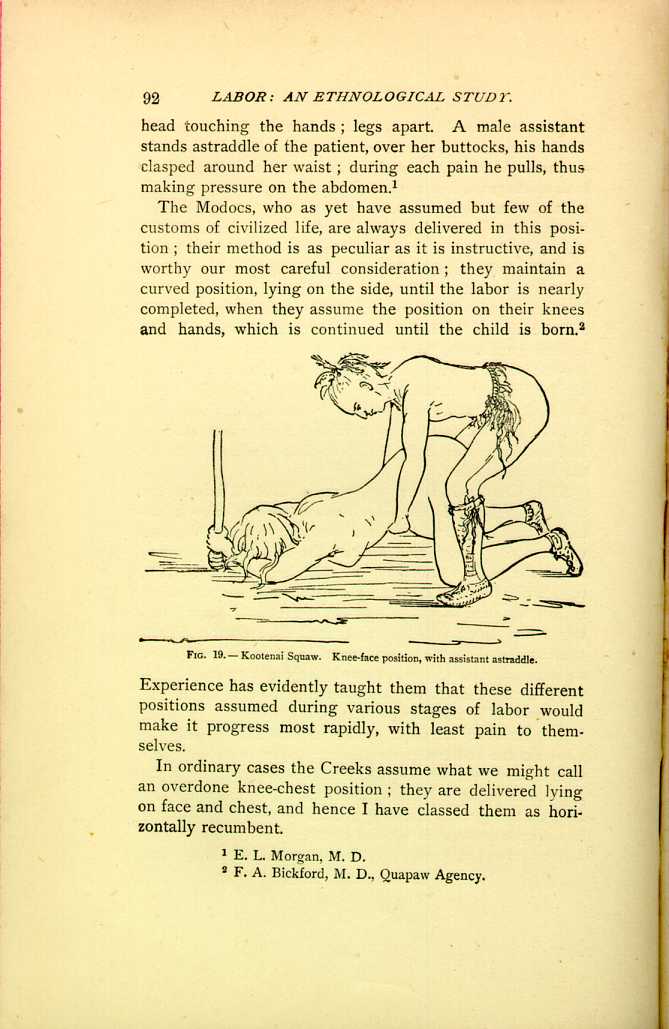| CHAPTER II.
POSTURE IN LABOR. Labor Among Primitive Peoples | ||
(b.) Knee-Hand or Knee-Elbow Position.
The knee-elbow position seems of old to have been recommended by the ablest obstetricians for very stout persons. Thus Soranus, and later the Arab, Jahiah Ebu Serapion, and Rhazes, who lived in the first half of the ninth century, advises the knee-elbow position under these circumstances;
In 1779, Hopkins objected to the lateral position and urged that the position on the hands and knees was the best.[64] Denman was of opinion that "this posture is instinctively sought by unassisted women.''[65] Whilst in 1791 that shrewd observer Charles White quoted Denman approvingly, and argued that the "knee-elbow position in natural labor prevented too great a pressure on the perineum.[66] According to Ramsbotham,[67] "the peasantry of Ireland placed themselves upon their hands and knees, and in Cornwall it is difficult to persuade the woman in labor to take any other posture than standing or on her knees.'' It is interesting to see how people carry these customs, which have been traditional among them for ages, across the seas.
We have seen the southern Negroes following the African ways, and the same may be observed among the Welsh, the Irish, and Germans; thus, Dr. H. C. Yarrow tells me that he had a patient once, a Welsh woman, who insisted on crawling on hands and knees while the pains were progressing, and who informed him that in Wales women frequently assumed this position or were delivered sitting upon the laps of their husbands. Irish women, who, as I am informed by several correspondents,[68] are in this country delivered in the hand and knee position, assert that this is
Major Charles R. Greenleaf, surgeon U. S. A., informs me that the Nez-Percés and Gros-Ventres women, who in ordinary labor are confined in a stooping posture, in cases where labor is protracted assume the knee-elbow position, whilst the patient's abdomen is encircled by a broad belt, upon which force is exerted by assistants, placed on either side of the patient, who scrupulously direct this force backwards and downwards during pains. The doctor himself witnessed such a case of protracted labor in a Gros-Ventre squaw, a primipara, who assumed the ordinary knee-elbow position and about whose abdomen a belt, often called the "squaw-belt,'' was placed.
The pressure exercised by the "squaw-belt'' among the Gros Ventre Indians is supplied by the pillow among the Creeks, and the encircling arms of an assistant among the Kootenais, whose labors are conducted in a most peculiar fashion, the parturient taking the knee-elbow position; she is on her knees, the face touching the ground; hands, one above the other, grasping a pole planted in the ground,
The Modocs, who as yet have assumed but few of the
customs of civilized life, are always delivered in this position;
their method is as peculiar as it is instructive, and is
worthy our most careful consideration; they maintain a
curved position, lying on the side, until the labor is nearly
completed, when they assume the position on their knees
and hands, which is continued until the child is
born.[71]

FIG. 19.—Kootenai Squaw. Knee-face position, with assistant
astraddle.
[Description: Woman kneels face down, gripping upright pole. Assistant
stands astride her with his hands just above her abdomen. Black and
white illustration]
In ordinary cases the Creeks assume what we might call an overdone knee-chest position; they are delivered lying on face and chest, and hence I have classed them as horizontally recumbent.
The natives of the Micronesian[72] and surrounding islands, like the Modocs, are delivered upon their hands and knees, sometimes in a recumbent position; certain of their old women act as midwives.
They roll about as they please until the very last stage the expulsion of the child, when they take this position, upon the hands and knees, and retain it usually until the placenta is expelled. They have no peculiar ceremonies, but apply to their ghost workers for intercession in their behalf in case of difficult labor or sickness. Massage and expression are used, especially for the expulsion of the placenta and after labor, to hasten the contractions of the womb, when the woman lies upon her back and her belly is kneaded. Difficult labor occurs seldom; and during thirty years' residence among the natives on the Micronesian Islands Mr. Sturgis, my informant, has never known of a single case of death of the mother in labor.
| CHAPTER II.
POSTURE IN LABOR. Labor Among Primitive Peoples | ||